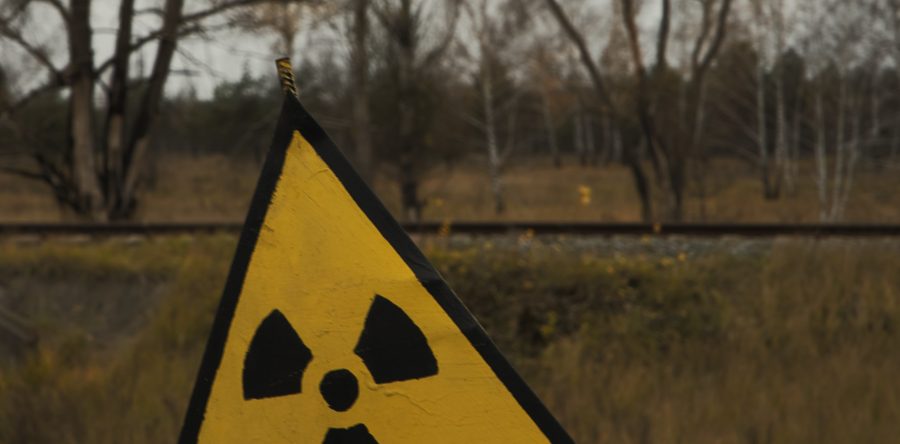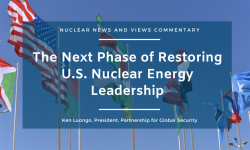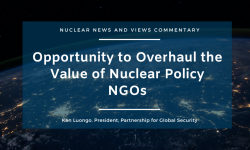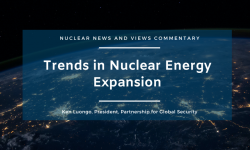The global nuclear guardrail system is being seriously challenged and steadily weakened. Built laboriously over numerous decades to manage a variety of nuclear risks, the arms control, non-proliferation, and nuclear security systems are flagging in the face of new realities, particularly intensifying geopolitical competition, emerging disruptive technologies, and evolving nuclear players.
Adapting to these new realities and rebuilding the eroding system of nuclear controls is essential for global security in this century. But the intellectual, political, and diplomatic tool kit that is required to achieve this goal needs to be significantly supplemented and previously reliable strategies for making progress updated. Unfortunately, there is not much evidence of this evolution.
Nuclear arms control’s progression has not only come to a stop, its previous accomplishments are being reversed. The U.S.-Russian Anti-Ballistic Missile (ABM) and Intermediate Nuclear Forces (INF) treaties are gone. New START, which needs to be renewed by early 2021, may not get that extension, unconstraining the two largest nuclear arsenals on earth.
New technologies for weapon delivery, a frost in U.S.-Russian relations, uncertainty over how to deal with China and its nuclear weapons, evolving challenges to the security of space-based assets, and an expanding nuclear arsenal in states like India and Pakistan are all complicating any potential next phase of arms control.
It was difficult enough to pursue bilateral weapon constraints. But engaging multilaterally or in multiple bilateral arms control dialogues risks overwhelming the shriveled diplomatic capacity in the U.S. and exposing the equivocal political will of nations to seriously act on this agenda. That has a direct impact on the integrity of the Non-Proliferation Treaty (NPT), which requires progress towards nuclear disarmament by the major weapons states.
Beyond stalled disarmament, the international non-proliferation and security regimes are under significant stress from non-compliance, lack of threat consensus, and the evolution of civil nuclear energy.
North Korea continues to defy the international community and advances its nuclear weapons program despite intensive engagement by the U.S. and South Korea to reverse it. The Joint Comprehensive Plan of Action (JCPOA) has been abandoned by the U.S. and Iran has responded by exceeding some of its limits and threatening to break through others. Concern about the deployment of nuclear technology in unstable regions will stress the NPT and its safeguards system as well as expose the declining ability of the U.S. and its allies to influence the nuclear export market and strengthen its rules.
The introduction of next generation advanced nuclear reactors that are smaller, deployable in remote locations, and that use non-traditional fuel cycles is increasing the pressure to rapidly update the effectiveness of the non-proliferation and security governance systems. The international community has not responded to this need with any urgency.
International consensus on the nuclear terrorism threat remains elusive and there have been several steps backwards after significant progress. The U.S.-Russian threat reduction agenda, and particularly its focus on cooperative nuclear material security, has all but dissolved. The five nuclear security action plans developed under the four heads-of-state Nuclear Security Summits (NSS) were designed to propel further progress to prevent nuclear terrorism. But implementation has faltered. As a result, the global nuclear security system remains primarily voluntary, opaque, and vulnerable.
Global circumstances and challenges have significantly changed. The roster of nuclear needs has expanded and the system by which these existing and future challenges are being managed is increasingly sclerotic.
Significantly increased pressure is being exerted by new technologies that are outpacing controls and new players that want to make their own rules. The old arms control, non-proliferation, and nuclear security approaches and playbooks need to be updated. But there is little creative thinking about how to design this evolved system and little political focus on driving it forward.
Lamenting the demise of discarded agreements won’t bring them back or prepare us for the future. It is time to stop mourning what has passed and focus on what needs to be created and how it effectively can be done. The international community needs to rebuild the global nuclear guardrails that address new realities.
Ken Luongo, President, Partnership for Global Security






